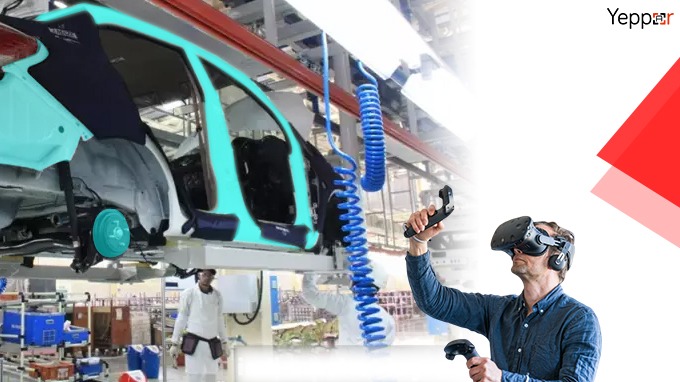Virtual reality is creating a revolution over the conventional training styles to give industrial training an advanced touch in business, military, engineering, healthcare, or any other industry.

Taking the instance of NYPD training their officers for active shooting scenarios to the neurosurgeons preparing for brain surgery, virtual reality offers amazing opportunities to safely train the professionals by saving huge costs.
A headwear immersing trainees to explore a new dimension similar to their working environment to learn better with a VR instructor. You could imagine the experience like a gamified version of your profession!
It’s not just that VR makes training immersive and learning fun, there are much more than that. Let’s take a quick look over the benefits of virtual reality training in complex technical systems.
Minimum Training Time
When it comes to manufacturing, time is a precious element and the traditional methods of technical training consume extensive time for new employees to be efficient on the floor. As a matter of fact, new workers can’t add value to the workforce until they complete their training. With the physical training sessions taking so long, the company incurs more expenses.
VR integrates interactive training modules to allow businesses to decrease the time taken to bring new workers up to their full potential. Virtual reality focuses on an individual approach to virtually train and examine each trainee in a batch. With a virtually integrated trainer for each trainee, the training gets more effective and easier, saving time and also makes the new employees achieve their full working potential.
Minimal Training Cost
Training in the manufacturing engineering field involves a bunch of expenses. The conventional training methods like on-ground sessions with experienced and skilled instructors who may charge per day, session, or batch. And, if you are picking the trainer from the master technicians on the floor, that means there would be a severe loss in the production.
Probably, a new hire under training may need two expert engineers, one as an instructor and guide, while the other sets up the equipment to feed the trainee. With VR training, employees can individually learn at their own pace, with the least involvement of a trainer, as the leading VR training module developers integrate a virtual trainer/guide to instruct the trainees accordingly. The training requirements of the company would be fulfilled with the virtual modules, to help new employees with the process of allocating resources to product-oriented tasks.
Safety Levelled Up
Factories and production units are highly hazardous environments to work in. The workers in the manufacturing scenarios seem to be safely geared up with helmets and more as a precaution. Virtual reality training simulates real work environments and scenarios to offer opportunities without putting new joiners in danger or other people who are depending on them.
So, VR training would be preparing the newcomers to handle the machinery and dangerous scenarios, to make them confident before they get their hands on the actual equipment.
Save the Materials
The conventional onsite training methods utilized the manufacturer’s physical materials in order to prepare trainees according to the actual workflows of production. Post-training, these once-used materials cannot be used later in the production procedures, which is a major expense. This could be a severe problem for the manufacturing companies that deal with costly expendables, for instance, in the aviation industry.
VR training modules simulate production pipelines that don’t require any real materials and can save the material for the actual production process. The trainees could utilize the simulated virtual resources to save a huge amount for the manufacturer.
Avoid Equipment Downtime
When in a technical environment, the trainees must have the know-how of the machinery at the workplace. Allocating equipment for training never seems to be a fine solution. It may end up expensive and may need high maintenance as well. If you have set a piece of equipment for training, it probably could not produce any marketable goods. In terms of finance, we could mention the equipment as idle.
Virtual reality training lets the manufacturers train the workforce with virtually replicated machinery, so as to reduce the downtime of productive equipment. As the trainees get ready to use the machinery, they will be more prepared to be more productive with lesser interruptions.
In-Depth Learning
VR training modules are highly advanced with an immersive digital experience. The modern training tactics within the technology let the trainees learn about the machinery, work environment, and its technicalities in depth. The highly realistic visual content along with spatial audio makes learning interesting and engaging for the newcomers to quickly grasp the knowledge.
Advanced training tactics and tools help them understand better to retain knowledge for a longer period. Features like highlighting and exploded view give them a clear view of the interior of the equipment with extremely demonstrative virtual presentations. VR training could also create awareness among trainees regarding the possible crashes and emergency scenarios in the work environment, to prepare them for any unfortunate mishaps in the work environment.
It helps avoid such hazardous situations and also prepares them with precautions to avoid harm to life, to improve safety at the workplace.
Conclusion
With VR training bringing in capabilities beyond possibilities to empower industries with immersive and effective learning, more and more companies are replacing traditional methods with modern training methods. It is highly visible that VR training solutions have been effective in enhancing the quality and efficiency of training.
The slowly shifting trends in the industrial training segment are evidence of the revolution to ease and engage the training style to comprehend complex systems. VR is here to change for good, phase by phase!












